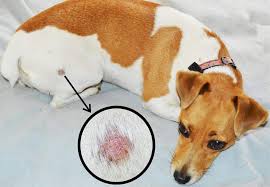Ringworm in dogs is a common condition that can be challenging to get rid of. Here, you will learn the signs of ringworm in dogs, how it’s diagnosed, treatment and how to prevent the spread to other pets.

What is ringworm in dogs?
When I first noticed ringworm on one of my dogs, I was surprised by how similar this fungal infection looked to athlete’s foot that humans get. This fungus can easily spread between animals and pets, which makes it a real challenge for pet parents to manage. The signs can start subtly—small red patches or scaly skin—but catching it early helps your veterinarian swiftly address the infection and prevent it from affecting other pets in the household. From my experience, staying calm and proactive in this battle makes a big difference. If you notice anything unusual about your dog’s condition, don’t wait; getting help early keeps the situation under control and protects your furry family members from this tricky infection.
What does ringworm look like on a dog?
When I first saw ringworm on one of my dogs, it showed up as strange patches of hair loss with a crusty coating that I almost missed at first. Some pups can be asymptomatic, showing no obvious signs, while others, especially young or elderly dogs with long hair, may be more impacted by this condition. I’ve noticed that my canine companion once had grey, scaly, and even bald spots that later turned bright red with small lesions—a clear sign something was wrong. If you notice similar symptoms, don’t wait to book a veterinary appointment, as early care can make a huge difference in keeping your dog comfortable and healthy.
- Dry, brittle hair
- Inflamed, red skin rash
- Circular or patchy areas of hair loss
- Scales that look like dandruff
- Scabs or lesions on the skin
- Darkened skin
- Reddened skin
- Inflamed folds of the skin around the claws or nails
- Itchiness
How is dog ringworm diagnosed?
When my dog first showed signs of ringworm, I immediately scheduled a veterinary visit so the veterinarian could properly diagnose the infection. During the physical examination, the vet carefully checked the affected areas, noticing circular patches of hair loss, redness, crusting, and scaling on the skin. To confirm the presence of the fungus, they used a Wood’s lamp, which emits an ultraviolet light that can make infected hairs fluoresce. For a more definitive diagnosis, the vet performed a fungal culture by collecting samples of hair and skin to identify the exact fungus causing the issue. Once confirmed, we discussed an effective treatment plan to help my pet recover quickly and safely.
What is the treatment for dog ringworm?
When my dogs were diagnosed with ringworm, the treatment process focused on helping them eliminate the fungal infection and promote healing. Most veterinarians prescribe antifungal medications, either oral or topical, depending on how severe or widespread the cases are. In mild or localized infections, treatments like shampoos and creams can combat the problem effectively. I also found that regular bathing with medicated products helped remove spores from their coat. With consistent care, my pets began to recover, and their skin looked healthy again within a few weeks.
Is it possible to stop the spread of ringworm in dogs?
From my experience, ringworm can endure for several weeks or even months if not properly managed, and its spread is often caused by direct contact with an infected animal or surface. The fungal spores can easily stick to contaminated surfaces, fibers, or even the carpet, bedding, and curtains, making control more difficult. I learned that every area must be thoroughly cleaned to stop the fungus from continuing to survive. Regular disinfecting and washing helped me stop recurring infections and protect other pets in the home.
Do I need to quarantine my dog if they are being treated for ringworm?
When my dog was diagnosed with ringworm, I quickly learned how important it was to confine the affected pet to a specific room in our home. Even asymptomatic animals can be carriers, shedding spores that are incredibly resilient and can survive in the environment for weeks. Keeping your pup contained during treatment is essential to reduce the spread and stop others from becoming reinfected. Regular cleaning of bedding, grooming tools, and living areas plays a big role in helping the condition heal faster. I also made sure to keep the ongoing care consistent until the virus was fully eliminated—only then did my pet finally recover completely while treating the infection safely.
How long should I quarantine a dog with ringworm?
When my dog was quarantined for ringworm, the battle lasted several weeks, but the right treatment made it easier and more inexpensive in the long run than dealing with recurring cases. During the process, my veterinarian emphasized constant monitoring of the skin and condition to ensure the infection stayed controlled. Regular adjustments to the plan were made after each appointment with the vet, who helped diagnose any changes and offered medical advice based on their informational expertise. For pets facing ringworm, patience and consistency truly make the recovery smoother and help prevent it from returning.
How can you tell if your dog has ringworm?
When my dog had ringworm, the first thing I noticed were the noticeable symptoms on his skin—it looked inflamed and red, almost like a rash. There were small scales that reminded me of dandruff, and he started showing mild itchiness, also known as pruritus. These signs can sometimes be mistaken for other skin issues, but with close observation, it became clear something more serious was happening. Recognizing these early symptoms helped me act quickly and get my pup the care he needed.
Do I need to quarantine if my dog has ringworm?
When my pet had ringworm, my vet suggested I quarantine him right away to minimize the spread of infection. I chose a small room that was easy to clean and kept other pets away to restrict contact. I made sure the area was always sanitized and only accessible to me. I kept a window open to let in fresh air and good ventilation, which helped keep the environment dry and healthy. It wasn’t easy seeing my dog isolated, but I knew this routine was important for his recovery and for keeping everyone else safe from getting infected too.
What kills ringworms on dogs?
Topical Treatment
Various creams and ointments containing miconazole (Micaved®), terbinafine (Lamisil®), or clotrimazole (Otomax® or Otibiotic®) are available to apply to localized areas of skin affected by ringworm.
What looks like ringworm in dogs?
Many bacterial skin infection cases in dogs can look similar to ringworm, especially to the untrained eye. When I first saw those round, red patches on my dog, I thought it was ringworm, but my vet later diagnosed pyoderma instead. Yeast infections and allergies are also common problems that affect dogs and often cause the same kind of itching and irritation. These infections can easily be mistaken for fungal issues, which is why getting a proper diagnosis is so important before starting treatment.
Will dog ringworm go away by itself?
When my pet first got ringworm, I noticed small affected areas on his skin that seemed hard to heal. My veterinarian explained that while ringworm can sometimes go away on its own, it’s safer to treat the infection to keep my dog comfortable and prevent it from spreading. She suggested using shampoos, creams, or even antifungal pills depending on how severe it was. Since my dog was one of those long-haired animals, she also recommended clipping his fur short to help the skin stay dry and speed up recovery. Following her advice made a big difference, and I could see his skin improving every day.

Pingback: Dry Air Affect Your Dog's Skin? Don’t Ignore It!